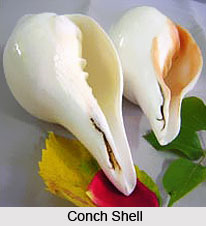 Firstly, one should take a right handed conch. On Thursday, after taking a bath, the worshipper should put the conch in a plate. It needs to be washed in Panchamrit. One should keep the conch on a red cloth and worship it with sandal paste mixed with saffron, camphor, flowers, rice, scented incense sticks and oil lamp. One needs to count the beads of a rosary while reciting the mantra - "Om Hreem Shreem Kleem Shreedhar Karasthaya Payonidhi Jataya Shree Dakshinavarti Shankhaya, Hreem Shreem Kleem Shree Karaaya Poojyaaya Namah". A Brahmin boy must be fed and lended some money (Dakshina). Later, one needs to spread the red cloth over a silver pot. The conch shell must then be placed on it. It is mandatory to worship the conch everyday, like an idol of a divinity. If silver pot cannot be obtained, a wooden pot can always be used instead and a tiny piece of silver can be placed beside the conch shell. Now, one must worship them respecting them like Goddess Lakshmi and Lord Vishnu, with utmost veneration. The conch shell will bestow success on the worshipper after resolving his or her monetary troubles.
Firstly, one should take a right handed conch. On Thursday, after taking a bath, the worshipper should put the conch in a plate. It needs to be washed in Panchamrit. One should keep the conch on a red cloth and worship it with sandal paste mixed with saffron, camphor, flowers, rice, scented incense sticks and oil lamp. One needs to count the beads of a rosary while reciting the mantra - "Om Hreem Shreem Kleem Shreedhar Karasthaya Payonidhi Jataya Shree Dakshinavarti Shankhaya, Hreem Shreem Kleem Shree Karaaya Poojyaaya Namah". A Brahmin boy must be fed and lended some money (Dakshina). Later, one needs to spread the red cloth over a silver pot. The conch shell must then be placed on it. It is mandatory to worship the conch everyday, like an idol of a divinity. If silver pot cannot be obtained, a wooden pot can always be used instead and a tiny piece of silver can be placed beside the conch shell. Now, one must worship them respecting them like Goddess Lakshmi and Lord Vishnu, with utmost veneration. The conch shell will bestow success on the worshipper after resolving his or her monetary troubles.
One needs to take into account the defects of a conch. The conch must be hole-free and its mouth should never be opened to blow it. It should be allowed to close as it is. The shell`s open portion must be on top, it`s back should be on the seat. The top portion should be facing the worshipper and the rear portion the wall.
Importance of the conch -
A Conch Shell, just like other gem stones or rudraksha malas, is capable to perform miraculous remedial feats, if only is taken seriously and with utmost faith and reverence. Therefore, its importance increases manifold when it is considered such a divine element.
1. The holy water inside the shell can obliterate every wickedness of a man when spattered on him.
2. If a man pours milk into the shell and again pours this milk back on the idol of goddess Lakshmi, his affluence is bound to increase.
Precautions- There is a panic of commotion, grief and devastation within the family if the right handed conch shell is blown after opening its month.
More on Counch Shell
Types Of Conch Shell




















